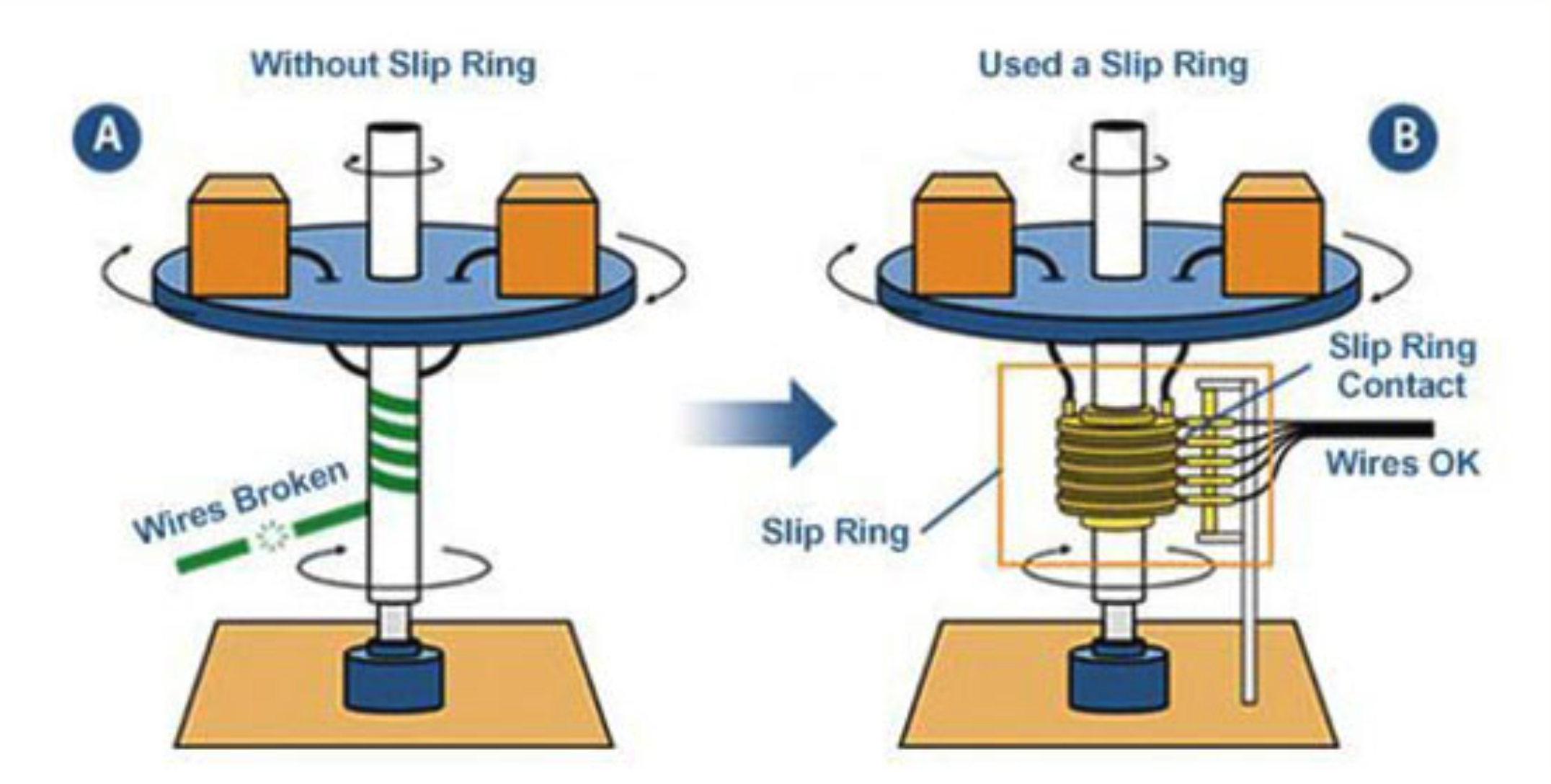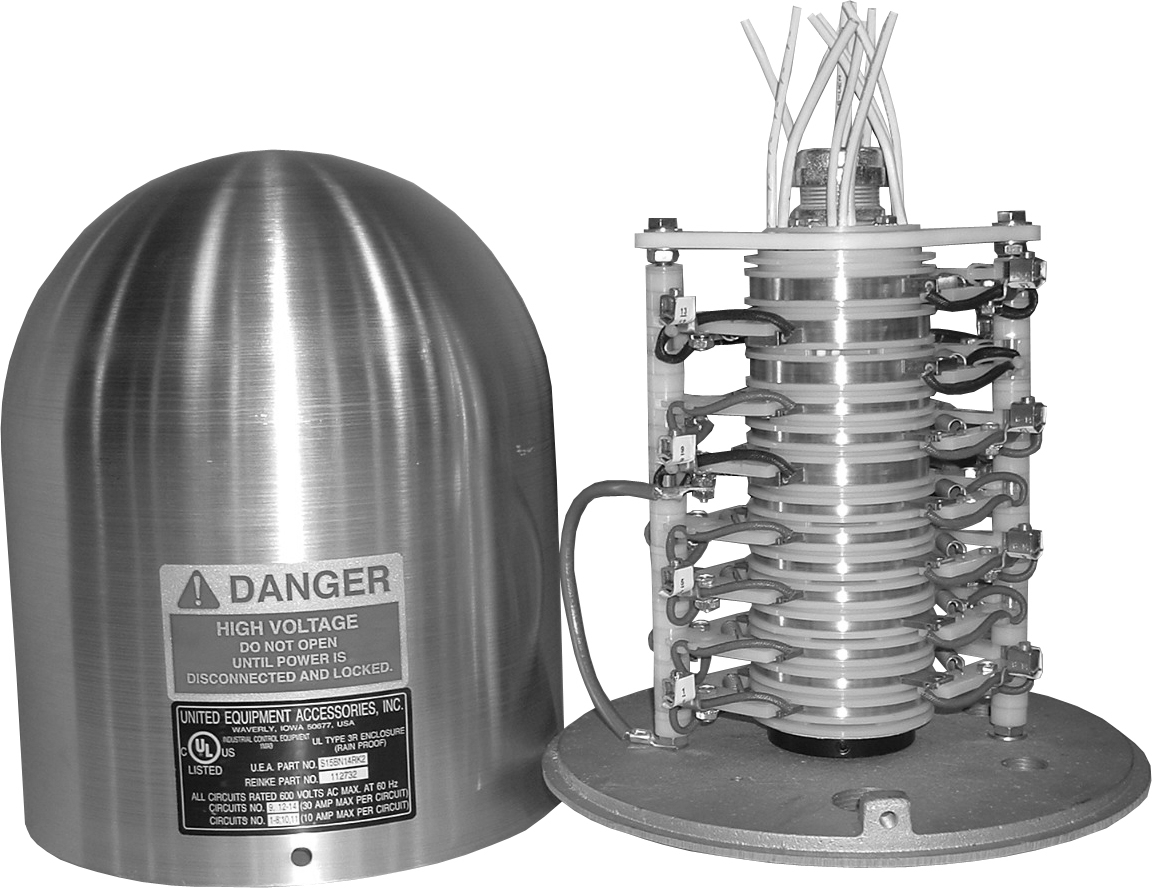What is a Slip Ring?
Imagine you have a rotating joint. This could be a radar, CT scanner, or a satellite’s solar panels. You have an end effector that needs power, but you have a problem . . . it is constantly spinning. If you were to pass wires through or around the joint, after enough turns the wires would break.
This is where a slip ring comes in. Using conductive brushes and rings (there are other mechanisms that work as well), a slip ring allows you to pass power/signal through a rotating joint.
History
The basic principle of slip rings can be traced back to the late 19th century when they were initially used in early electrical experiments and the development of electrical generators and motors. With the advent of the Industrial Revolution and the increasing demand for electrical power, the technology behind slip rings started to evolve. They became essential components in large-scale electrical machinery, such as turbines and generators, allowing for the transfer of power and signals in machines where a part of the machinery needed to rotate continuously. The mid-20th century saw significant advancements in materials science and manufacturing processes, which led to new materials for brushes and rings, such as silver and graphite which reduced wear and improved the efficiency of power and signal transmission.
Basic Slip Ring Fundamentals
Packaging:
Slip rings are unique components where in some applications having a stand-alone assembly makes sense. However, if the slip ring is integrated into a larger assembly and packaging space is at a premium, you can by the rings and brush separately and package them yourself.
Slip Ring Separates - brushes and rings sold as separate assemblies that you would then integrate into a rotary joint
Slip Ring Capsule - a pre-packaged set of brushes and rings already constrained together and often weatherproofed.
Configuration:
How the brushes and rings are configured is also important. If radial width is critical then you want to use a drum-style slip ring that has rings stacked. If axial height is a premium then you want to use a pancake slip ring that positions the rings concentric to each other.
Drum - rings are stacked along a centerline
Pancake (or platter) - concentric rings -> usually worse performance than a drum
Leads:
Well, the whole point of a slip ring is to pass electrical current mechanically so how you interface with that is important. If you buy an off-the-shelf slip ring most likely you will be given “flying-leads” which means bare wires that you are expected to crimp/solder. These wires can either come out of the slip ring radially or axially. Now if you are working with a slip ring company to make a custom slip ring for your application, you can ask for connectos. These can either be attached to the leads mentioned earlier or built into the casing of the slip ring.
Axial - leads come out vertically, usually both sets on the same side.
Radial - leads come out on the outside of the slip ring on the cylindrical face.
Connectors - these are custom and can be whatever you would like. RJ45 is common for ethernet and Mil-Spec connectors are common for high IP-rated slip-rings.
IP Rating
I’ll direct you here for the full breakdown, but generally speaking, the first number is dust protection and the second is water protection. Slip rings usually fall into 2 categories, sealed (IP54 to IP68) or open (IP00-IP43), it’s kinda of a spectrum so it really can vary from supplier to supplier, and be careful, just cause they give it a rating doesn’t mean it has been tested.
Some Key Notes:
Current dictates ring cross section
Voltage dictates spacing between rings
Slip rings are not bearings, they are not meant to provide structural support for motion. Thus, a flexible coupling is required on one side otherwise there will be early failure
Here are all the companies that make slip rings in the U.S.
Location: Carlsbad, CA
Email: sales@mercotac.com
Phone: (760) 431-7723
It’s in the name, Mercotac sells brushless slip rings that use mercury.
The pro is a significantly longer life.
The con, there is mercury and they aren’t IP 68. But if you need 2-8 leads passed through a moving joint these could be a great option!
IP51
1-8 Rings
-29 to 60 °C
AC, DC
300-7.5k RPM
30A
N/A
None
N/A
Location: Waverly, Iowa
Email: info@uea-inc.com
Phone: (800)-394-9986
United Equipment Accessories is one of the bigger players in the industry. They offer large slip rings and can integrate hydraulics.
The downside is that they probably move on the slower side of things.
IP68
1-120 Rings
-40 to 93 °C
AC, DC, Ethernet
3,000 RPM
1000A
Graphite, Silver
.5” to 14”
Brass, Silver
Location: Christianburg, Virginia
Email: rotarysolutions@moog.com
Phone: (540)-552-3011
MOOG is the heaviest hitter in the US Market. They make slip rings for defense companies, major industrials, and aerospace. They know slip rings better than anyone (look how extensive their catalog is). Unfortunately, because they are so large, they move slowly and don’t work with small companies
IP65
1-72 Rings
Unkown
AC, DC, Ethernet
20,000 RPM
500A
Gold, Silver
1.5” to 9”
Gold, Silver
Location: Ramsey, Minnesota
Email: info@rotarysystems.com
Phone: (800)-959-0146
MOOG is the heaviest hitter in the US Market. They make slip rings for defense companies, major industrials, and aerospace. They know slip rings better than anyone (look how extensive their catalog is). Unfortunately, because they are so large, they move slowly and don’t work with small companies
IP68
1-50 Rings
Unkown
AC, DC, Ethernet
10,000 RPM
50A
Gold, Silver
.5” to 4.75”
Gold, Silver























